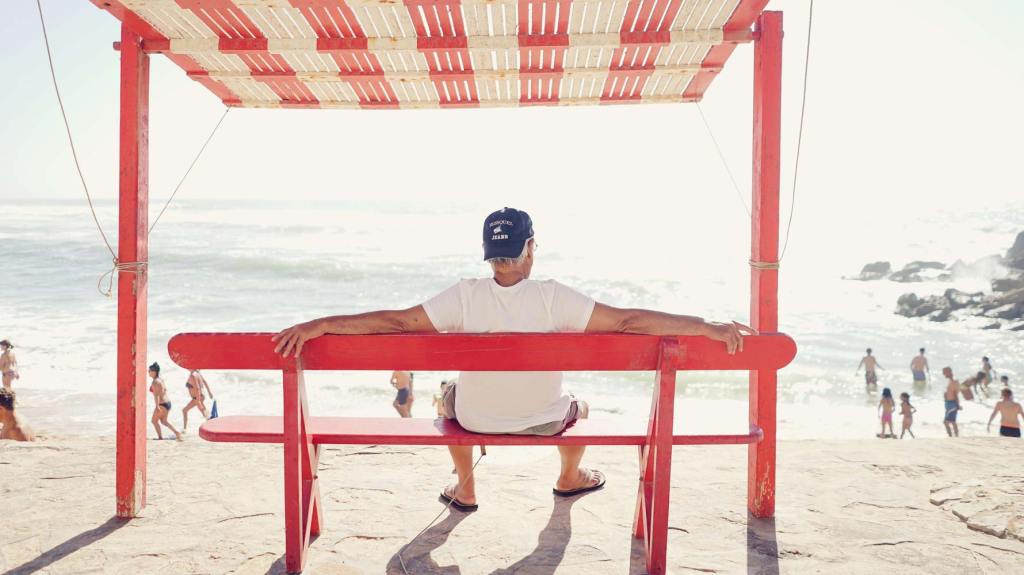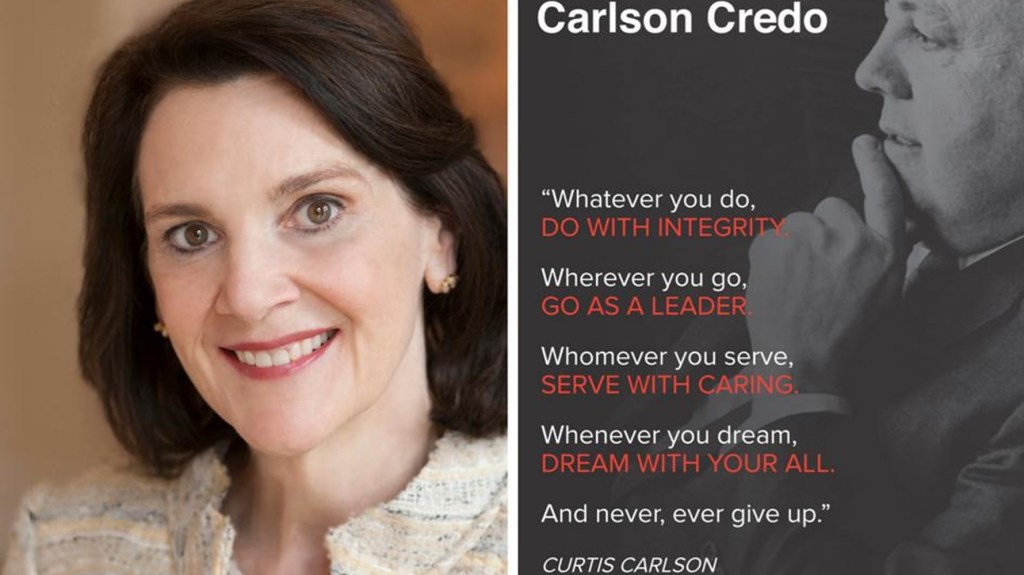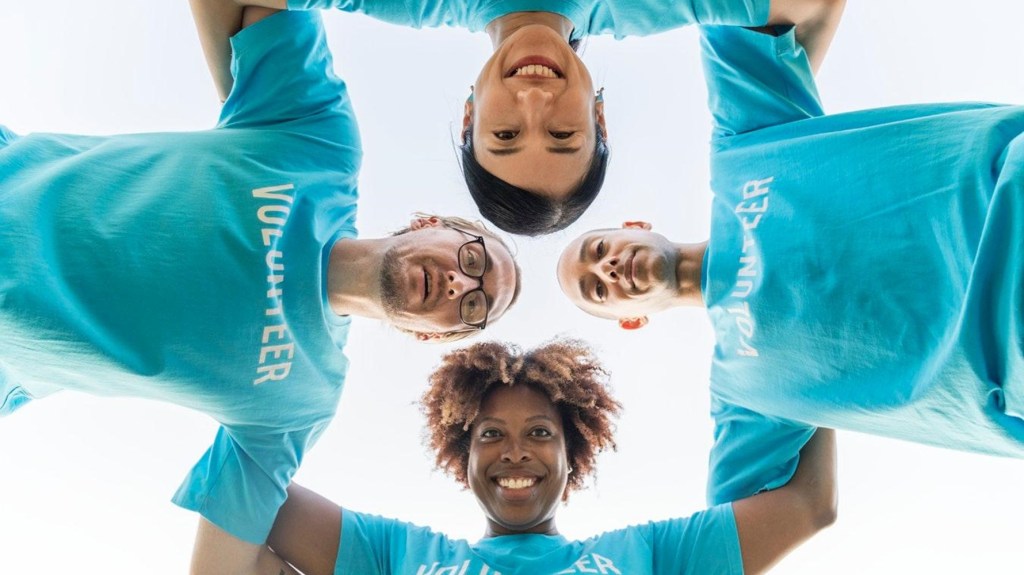Introducing the latest myCWT product and service enhancements
Building on our digital, omnichannel myCWT platform, our new products and services will simplify travel management for you and your employees – anytime, anywhere, anyhow.
Note: Featured services may not be available in your country at this time. Please reach out to your CWT representative for more details.
Hear from Chief Product Officer, Erica Antony as she shares the key product highlights of 2024, along with the key areas driving innovation.
-

2040: Baseline, Boom or Bust
As we enter an era of rapid transformation and unprecedented challenges, it is essential for travel managers, meeting & event planners, and corporate decision-makers to look ahead and frame our current strategic thinking with a clear vision of the future. Business travel and meetings and events (M&E) are poised for significant change over the next decade and a half, driven by a complex interplay of sustainability goals, technological advancements, evolving work models, and geopolitical dynamics.
In this paper to mark the 10th anniversary of our Global Business Travel Forecast, we explore, for the first time, a long-term vision of the future and potential trajectories through three distinct scenarios, each offering insights into how these forces should affect policy-making, budgeting and priorities. By examining these scenarios, we can better understand the diverse possibilities that lie ahead and the strategic imperatives required to thrive in each potential future.
Based on trajectory data analysis and interviews with industry leaders, behaviorists and climate tech founders, this forward-looking approach enables us to anticipate changes, strengthen our strategies, and make informed decisions that align long-term objectives. It is through this lens of foresight and adaptability that we can build resilience, seize opportunities, and navigate the complexities of the future.
We invite you to reflect on the insights presented, and consider how your organization can prepare for the opportunities and challenges that lie ahead. Together we can ensure that travel and meetings remain catalysts for growth, scalability and sustainable practices.
- Scenario development is both an art and a science
- Megatrends Shaping the Future of Business Travel, Meetings and Events
- Sustainability goals the new crux of corporate policy
- Technology Revolutionizes Travel Management
- Modern work models spark new travel patterns
- Changing demographics open doors to new opportunities
- Three Scenarios: Base case, boom and bust
- Future-proofing strategies

-

CWT GBTA Global business travel forecast 2025
When it comes to pricing, global business travel has finally reached an enduring, higher baseline. Prices will continue to rise in 2025, but only moderately, so expect a period of normalized growth.
However, this pricing environment, one of marginal gains and price regularity, is fragile. Global leisure travel has now realized a lot of its pent-up demand, while corporate travel has been resurgent, with 2024 edging at preCovid levels.
There are many factors at play, whether its volatile oil prices, labor costs and constraints, inflationary pressures, and geopolitical factors. As this elevated baseline edges upwards, albeit marginally, travel budgets will come under increased scrutiny, especially as travel patterns and attitudes change.
It’s why business travel can’t be viewed in a silo, and the true value to an organization must be fully realized. This forecast can help with those calculations.

-

Capitalize on emerging technologies in corporate travel
Technological advancements are accelerating at an unprecedented pace. How will emerging innovations like Generative AI, blockchain, and self-sovereign identity (SSI) transform corporate travel?
BTN and CWT probed global CEOs, travel managers, industry consultants and tech experts on the promises, questions, and expectations these innovations raise and how they are set to reshape traveler experience, cost control and service delivery in corporate travel and events.
Download and discover
- The technologies that will have the greatest impact on corporate travel in the next 2-5 years
- How these emerging technologies are poised to control costs, enhance service and security, and boost efficiency
- The critical challenges, opportunities, risks and roadblocks each innovation raises
- What travel managers, buyers and experts anticipate from these innovations

-

CWT / Travelport research: premium economy a hot ticket for Singapore business travelers
Carlson Wagonlit Travel (CWT), the global travel management company, and Travelport, the leading Travel Commerce Platform, have found that premium economy is the fastest growing cabin segment for business travelers in Singapore.
An analysis of over 1.3 million bookings made between January 1, 2015 and December 31, 2017, with Singapore as the point of origin, showed that the number of premium economy seats booked for corporate travel increased at an average rate of 157% year-on-year. In comparison, corporate bookings for other classes recorded negative growth over this three-year period.
“One can easily see the appeal that premium economy has for corporate travel programs,” said Richard Johnson, Director, Asia Pacific, CWT Solutions Group. “It gives travelers that much-needed extra comfort versus economy class on medium-to-long-haul flights, while costing their companies significantly less than a business class ticket.”
The seat share of premium economy as a proportion of total bookings has increased steadily, too. In 2015, premium economy comprised only 1.23% of total corporate travel bookings, and this grew to 7% by the end of 2017. Meanwhile, the economy class seat share declined to 54.46% in 2017, compared to 60.27% in 2015. Business class bookings have remained relatively flat, comprising 37.66% of corporate travel bookings in 2017 versus 37.59% in 2015.
“It’s interesting that the increase in premium economy bookings seems to have come largely at the expense of economy class, and not business class,” said Johnson. “This makes sense, given the trend we’re seeing where companies are looking beyond travel costs and paying more attention to traveler comfort and productivity.”
Flying economy class on medium- to long-haul flights was identified as the third-strongest stress-inducing factor for business travelers, according to an earlier study done by Carlson Wagonlit Travel called the Travel Stress Index. Such stress results in lost time and reduces the overall productivity of the traveler.
“When you look at corporate travel policies, we have seen more companies allowing their employees to travel premium economy over the last few years,” added Johnson. “Still, only around a quarter of our clients have policies that explicitly allow their travelers to book this cabin class, suggesting that there’s still a lot of room for growth for premium economy in corporate travel.”
Looking at supply, it’s clear that airlines are increasingly seeing a viable business case for premium economy. At the end of 2017, one in five airlines flying into Singapore offered premium economy, with the service available on more than 30% of routes from Singapore. For example, four in 10 planes from Singapore’s national carrier, Singapore Airlines, offer premium economy as an option, with plans to increase this further.
Supply seat share of premium economy versus other cabin classes has also increased at a steady pace. The number of premium economy seats available as a proportion of total airline seats increased from 2.47% in 2015 to 3.55% in 2017. The data suggests that airlines have made room for premium economy by reducing the number of first and economy class seats.
“With this trend we see, it has become even more imperative for corporates to work with technology partners and travel management companies who are able to provide accurate and comprehensive content choices for their travellers,” commented Mark Meehan, Managing Director Asia Pacific for Travelport. “Technology such as Branded Fares and Ancillaries, which can provide access to rich images of airline seat options and other airline products, will give corporates better value and coverage of available airline content.”
Carlson Wagonlit Travel
Companies and governments rely on us to keep their people connected. We provide their travelers with a consumer-grade travel experience, combining innovative technology with our vast experience. Every day, we look after enough travelers to fill more than 260 Boeing 787s and 100,000 hotel rooms – and handle 105 events. We operate in around 150 countries, and in 2017 posted a total transaction volume of more than US$ 23 billion.
Travelport
Travelport (NYSE: TVPT) is the technology company that makes the experience of buying and managing travel continually better. It operates a travel commerce platform providing distribution, technology, payment and other solutions for the global travel and tourism industry. The Company facilitates travel commerce by connecting the world’s leading travel providers with online and offline travel buyers in a proprietary business-to-business (B2B) travel platform.
Travelport has a leadership position in airline merchandising, hotel content and distribution, car rental, mobile commerce and B2B payment solutions. The Company also provides critical IT services to airlines, such as shopping, ticketing, departure control and other solutions. With net revenue of over $2.4 billion in 2017, Travelport is headquartered in Langley, U.K., has over 4,000 employees and is represented in approximately 180 countries and territories.
-

Go in peace – Discover the world’s top 10 most harmonious destinations
For 12 years now, the Institute for Economics and Peace elaborates the Global Peace Index. This report is a leading measure of global peacefulness. It bases its ranking in three factors: the level of societal safety and security, the extent of ongoing domestic and international conflict, and the degree of militarisation.
I believe that these three domains are very significant for traveling without a single worry, so let’s have a look at the 10 most peaceful countries in the world according to this report:
- Iceland.
- New Zealand.
- Austria.
- Portugal.
- Denmark.
- Canada.
- The Czech Republic.
- Singapore.
- Japan.
- Ireland.
Overall, Europe is the most peaceful region, and still, the report shows interesting data, with countries like France or the UK underneath others like Sierra Leone. Another surprising factor is that a country like the US, is in the 121st position, just on the verge of scoring a low state of peace.
But aside the importance of it for travelers, the report shows there is a high correlation between peacefulness and macroeconomic performance.
“In the last 70 years, per capita growth has been three times higher in highly peaceful countries when compared to countries with low levels of peace. The difference is even stronger when looking at changes in peacefulness, with the report finding that per capita GDP growth has been seven times higher over the last decade in countries that improved in peacefulness versus those that deteriorated.
Peacefulness is also correlated with strong performance on a number of macroeconomic variables. Interest rates are lower and more stable in highly peaceful countries, as is the rate of inflation. Foreign direct investment is more than twice as high in highly peaceful countries. In total, if the least peaceful countries had grown at the same rate as highly peaceful countries, the global economy would be almost 14 trillion dollars larger.”
So, with this in mind, let’s avoid hostility. It seems it pays off.
And, don’t worry. If you need to travel to an agitated destination, at CWT we have your back. So, wherever you go, go in peace.
-

The business of pleasure: Can you turn a conference into a bleisure trip?
You’ve heard the buzzword, you’ve seen the articles — but is “bleisure travel” really catching on? Yep, and we say: embrace it.
Travelers are increasingly taking advantage of bleisure travel (a portmanteau of ‘leisure’ and ‘business’) — and why not? A trip to a travel industry conference — like the upcoming GBTA Convention in San Diego, from 11 – 15 August — is a great excuse to explore a new city, meet new people and even have yourself an adventure.
A recent GBTA study found over one-third of North American travelers have extended a work trip for leisure. Research from CWT Solutions Group found that women, young people and infrequent business travelers are the most likely to take bleisure trips — but why shouldn’t everyone? Taking more vacation can actually improve your productivity and make you more likely to receive a raise or bonus, according to Harvard Business Review.
To help convert your conference into a full-fledged bleisure trip, we’ve compiled a few tips:
1. First Things First: Extend Your Stay
The first step in upgrading your trip from business to bleisure is to extend your stay. We’ll use the GBTA conference as an example. if you’re going to be in San Diego for a few days anyway, why not stay through the weekend and explore everything Southern California has to offer? Giving yourself a few extra days means you can take in the city while still getting the most of out of your conference.
But, we should note: If you are going to extend your trip, it’s probably a good idea to run it past your boss first and check if your company includes leisure time in its travel policy.
2. Business or Pleasure? How About Both?
When planning for the perfect bleisure getaway, we recommend making a well-thought-out itinerary for both work and play. Try balancing both by picking four expert panelists you want to see, and four can’t-miss local sights.
At the GBTA conference in August, catch some CWT panelists, including:
- Scott Brennan, President of CWT’s Hotel Americas, discussing how loyalty programs can improve your travel program (Monday, August 13)
- Katie Raddatz, CWT’s Senior Director of Solutions Group Americas, will be sharing the 2019 Global Travel Price Forecast covering global air, hotel and ground prices (Monday, August 13)
- Barbara Barnard, Senior Vice President, Americas, examining the benefits of industry collaboration (Tuesday, August 14)
- Kurt Ekert, CEO of Carlson Wagonlit Travel, moderating a panel of senior buyers (Tuesday, August 14)
For the ‘leisure’ part, try something quintessentially San Diego like exploring Balboa Park, home to more than 16 museums and the San Diego Zoo, relax at La Jolla Cove, a cliff-filled beach, or lunch on burritos at Nico’s.
3. Forget Tradition: Get Creative with Networking
Industry events, trade shows and conferences are fantastic locales for networking with folks across the travel world — from competitors to prospective customers. To get truly unique when meeting new faces at an industry event, break outside the traditional dinner and drinks.
Take clients to an escape room, visit a local craft brewery or rent bikes and see the town on two wheels. Using RoomIt by CWT, it’s easy to find preferred hotels (and apartments) right in the heart of the city.
4. Break Out Your Bucket List
A work trip is a perfect time to start crossing items off your bucket list. All too often, we spend our work trips trapped in client offices and hotel ballrooms. Instead, step outside your normal routine and try something the local culture has to offer, such as skydiving over the ocean or surfing. A bleisure trip is the perfect opportunity to wade into new waters.
5. Say Yes!
If someone at the conference asks you to dinner — say yes! If a panelist opens themselves up to questions, go introduce yourself and ask them out for coffee. The more you say “yes” to new opportunities, the more chances you have to create memorable experiences.
To have yourself a bleisurely weekend in San Diego, don’t forget to register for GBTA Convention, add CWT exhibitors to your convention planner and tack a few extra days on to your itinerary when booking.
-

Collective conscience – Why responsible products and services are smart business
Fair trade, organic, sustainable, eco-friendly, recycled: You probably recognize these terms since they’re emblazoned on many of the products and services that we purchase.
I already shared with you in a previous blog the findings of a study by Cone Communications in which 91% of global consumers said they expect companies to do more than make a profit. This research is not alone in proving a stark shift in shopping behavior towards conscious business.
In fact, we are experiencing it first hand at CWT, with more and more clients and prospects asking us how we can help them to further embed social, environmental and ethical considerations into their travel program.
Companies need to show a greater engagement, not only for the sake of our society and our planet, but also if they want to be successful in business. There is a trend towards responsible products and services worldwide and this collective conscience is likely to keep growing, as our planet faces more and more challenges.
At CWT we have reinforced risk management and enhance our products and services to help reduce risks associated with safety and security of travelers. Our reporting tool analyzes CO2 emissions after customers travel to provide managers with environmental data that can be shared to raise awareness of their environmental footprint and drive future behaviors.
We believe a responsible business is also one where critical functions continue to perform even under the most challenging conditions to protect stakeholders at all times, for that reason we regularly review our business continuity and back-up plans, to make sure we are always well-prepared to manage any disruption.
Stay tuned for more blogs about the importance of responsible business.
-

Fresh as a daisy – 7 ways to beat jet lag
Whether you are a road warrior, or occasional business traveler, it is very likely that you have already experienced the unbearable disassociation of time and tiredness that changing time zones can bring.
So, if you want to arrive at your meeting as fresh as a daisy and to outperform, I hope these seven jet-lag avoidance tips help:
- Preparation is key. Work not only on your presentation, but also on your sleeping routines. If you are going to travel east, go to bed earlier the week before your trip. If you are going to go west, stay up later.
- Choose your flight if you can. Our bodies work on a 24 hours cycle called circadian rhythms. When we travel, our bodies cannot adjust quickly enough, leading to sleep disorder. To minimize it, select, if you can, a flight that arrives early in the evening at your destination and try to stay up until bedtime to catch up as quickly as possible the new rhythm.
- Let the sunshine in. Get as much sunlight as possible if you want to regulate your biological clock. Daylight works far better than caffeine – so, if you are stuck in meeting rooms all day, use the breaks to go outside and take some fresh air.
- Cut out stimulants. Stay away from caffeine and strong exercise in the evening to allow your body to get ready for a good night’s sleep.
- Be water. I don’t mean be fluid. I mean, drink all the water you can, not only during your flight, but also before boarding. A well-hydrated body recovers faster, so ask for water to your flight’s attendants regularly.
- The grass really is greener. A weird tip I was once given (possibly by a fan of the movie, Pretty Woman, but I won’t let on) was to walk in bare feet on grass when you arrive somewhere. It is strangely relaxing and immediately takes you away from your worries – and jet lag.
- Trick your brain. It is really just a mind-over-matter thing, but it does help to set up your watch to the destination time zone, before you travel (but please don’t miss your flight as a result).
I hope you find these useful and please do let me know if you have any other tips which work.
- Preparation is key. Work not only on your presentation, but also on your sleeping routines. If you are going to travel east, go to bed earlier the week before your trip. If you are going to go west, stay up later.
-

Carlson’s 80th anniversary: Diana Nelson reflects
2018 marks Carlson’s 80th anniversary. This exciting milestone provides an opportunity to reflect on our history and celebrate our growth and evolution over the past eight decades. From our 1938 founding as the Gold Bond Stamp business to building a global, industry-leading hospitality and travel business, to the recent launch of Carlson Private Capital Partners, we remain a strong, family-owned private company committed to growth, job creation, and serving our stakeholders and communities into the future.
Over the course of our history, Carlson has reflected our entrepreneurial roots, transforming and changing our portfolio of businesses to respond to both risk and opportunity. Carlson has also consistently been guided by our core values, best embodied in the Carlson Credo:

Whatever you do, do with integrity.
Wherever you go, go as a leader.
Whomever you serve, serve with caring. Whenever you dream, dream with your all.
And never, ever give up.-Curt Carlson
Our anniversary provides a wonderful chance for me to express gratitude. Thank you to all the colleagues, partners, suppliers, and customers around the world who have helped make Carlson great for 80 years. We look forward to creating our future with you.
-

The rule of three – How we strengthen our community involvement
The Rule of Three is a style of communication which is often used in public speaking, or writing, to gain emphasis and focus on a core message on the premise that people respond subconsciously to groups of three.
There are many examples; from Shakespeare’s Julius Caesar (“I came, I saw, I conquered,”) to Steve Jobs (“Thinner, lighter and faster.”).
To work on our Community Involvement program, we have used the Rule of Three. Our efforts revolve around ‘3E’ – Education, Emergencies, and Essential needs. These are the areas where we are able to create the biggest impact thanks to the skills of our people.
Local teams are empowered to select projects reflecting their passions and the needs of the communities around them. Since the launch of our 3E Community Involvement program in 2014, our people have committed their support to hundreds of projects worldwide making a real difference in the communities where we live and work.
But the Rule of Three is not our only secret weapon.
The 3E Guidebook – an operational toolkit – helps our employees understand the 3E strategy. Currently available in seven languages, it gives them all the information they need to launch a local 3E initiative and make a success of it.
And, in order to have a clear picture of our impact, we also have an interactive 3E map that tracks and showcases the various 3E initiatives all over the world. It is a very graphic way to keep our engagement high.
Last but not least, we work very closely with Carlson and the Carlson Family Foundation on our community involvement programs. Believing that business can be a platform for positive impact is at the core of the Carlson ethic so, together, for example, we combine our efforts to increase our focus on fighting human trafficking across the globe.
What do you do to foster community involvement in your company? We would like to hear from you.
-

A guide to business etiquette
So you’re about to go on your first business trip. You know exactly what your meeting objectives are, who’ll be in the room, and where you’re staying afterwards – but do you know how to greet your client? How to dress? How to behave in meetings?
Business etiquette shouldn’t be an afterthought. Good manners are essential for getting ahead in the corporate world, and your grasp of business etiquette can make all the difference to winning – or losing – business. First impressions count, so check out this guide and make sure you’re representing your organization in the right way.
1. Arrive on time (at the very latest)
It’s rude to waste someone else’s time, wherever you are in the world. It doesn’t matter if you’re traveling to a meeting, a business lunch or a conference – you should always aim to arrive on time. Even better, try to get there five or 10 minutes early – then you’ll have time to compose yourself before the event kicks off.
Punctuality shows others that you value their time, while lateness comes across as inconsiderate. Of course, there might be a valid reason why you’re running late. If so, give the people you’re meeting plenty of notice.
One easy way to stay punctual is by using corporate travel apps such as myCWT, which syncs with your work calendar to give you the reminders you need to stick to your work schedule and travel itinerary.
2. Adapt to local customs
Respect the fact you’re a guest in the place you’re visiting by making an effort to understand local customs. Even things that have nothing to do with the specific business reason for your trip – such as learning a local greeting or making an observation about your surroundings – will be appreciated. In certain cultures, there might be bigger considerations to bear in mind.
For example, it’s against Japanese business etiquette to pat a man on the back or shoulder, or make small talk about family, religion or politics. In others, you’ll need to respect the tipping culture, which can vary depending on the type of service provided. Apps like myCWT feature tip calculators to point you in the right direction and avoid making any faux pas.
3. Be professional
While shaking hands might seem like the universal way of establishing business rapport, it’s not appropriate everywhere in the world. Making a good first impression starts with your ability to greet in the proper way – so find out how the place you’re visiting does this.
For example, it’s Indian business etiquette to place both hands together and bow slightly, rather than shake hands. You can also be professional by giving others your complete attention when they’re speaking – resisting the urge to talk to someone else in the meeting, take a call or check your messages.
4. Dress appropriately
Striking the right balance between comfort and courtesy requires some thought about what to wear for a business meeting. Do your research and don’t make assumptions – the business etiquette for how to dress varies considerably from one country to the next.
For example, you might presume that some of the hottest countries encourage modest dressing – but that’s often not the case. Dressing appropriately generally means dressing respectably, and certainly keeping your knees and shoulders covered.
5. Be respectful
Being respectful to others makes you pleasant to work with and shows politeness. You should avoid raising your voice in a work environment – and certainly avoid using bad language – keeping your tone as neutral as possible. It’s also disrespectful to interrupt other people when they’re speaking.
Refrain from criticizing another country’s infrastructure or bureaucracy. Even if your clients think you have a point, they won’t appreciate you drawing attention to the fact. Complaining should be kept to a minimum, too, as it could be considered bad manners.
Respect also applies outside of the office – particularly when you’re entertaining a client at a restaurant or other venue. While it’s good to establish a relaxed rapport with the people you’re meeting, it’s important to ensure you remain professional at all times.
6. Use common sense
You’ll need common sense in a million and one different situations that spring up on your business trip. For example, it’s important to keep business conversations private. You never know who might be sitting next to you on the train, so wait until you’re back in your hotel before chatting to a co-worker about the meeting you’ve just attended.
If your client is paying for your hotel, don’t book the presidential suite in a five-star palace – they might see it as evidence that you’re overcharging. And be careful about what you’re sharing on social media. Showing off about the opulence of your hotel or badmouthing the people you’re meeting could have serious consequences.
7. Negotiate smartly
Business etiquette in meetings differs greatly between countries and industry sectors. Wherever you are, however, it’s vital that you gauge the atmosphere in the room and adjust your approach accordingly.
Try to be assertive without being aggressive – never interrupt anyone, and be diplomatic even when you disagree with what someone else is saying.
8. Watch your table manners
Every country has different customs and traditions when it comes to eating, so it’s essential you read up on these before you travel. Common table manners, such as not speaking with your mouth full, using your napkin and keeping your bag off the table, need to be observed at all times.
If you’ve brought your partner or co-worker with you on your trip, check they have an invite to the meal rather than assuming – it could make things awkward for everyone if you don’t. Plus, it’s important that you’re not seen to be taking advantage of a client’s hospitality.
While politeness alone won’t be enough to make your business trip a success, it’s certainly a factor in convincing clients that you and your company are people they want to do business with.
9. Comply with your company’s corporate travel policy
Your company should have a corporate travel policy that outlines clear rules on everything from making airline bookings to claiming expenses and accepting gifts – and it’s important to comply with these. Your corporate travel policy is designed primarily to keep you safe on the move. It also establishes key policies in areas such as:
- Airline, rail, hotel and rental car reservations.
- The use of other transportation, such as taxi cabs.
- Rules for on-site spending, including meals, entertainment and phone calls.
- Security relating to travel – both in terms of personal safety and work materials.
- The rules around gifts and favors that may be bought or received during business travel, particularly in certain parts of the world.
- The approval process that employees and managers need to follow.
- The system for the payment of any expenses incurred during travel.
It’s essential to understand the dos and don’ts of local business etiquette so that you can conduct yourself professionally and represent your organization effectively. Get it right, and you could unlock more opportunities for your company – as well as boost your own career prospects.
-

Carlson Wagonlit Travel research: 3 in 10 business travelers value hotel rewards over safety
Globally, three in ten business travelers are happy to sacrifice safety for hotel loyalty and rewards incentives, according to research commissioned by Carlson Wagonlit Travel, the global travel management company. Travelers in the Americas are likeliest to do so (39%), followed by Europeans (34%) and travelers from Asia Pacific (28%).
“Clearly, travelers are very focused on their hotel loyalty points – they will go to great lengths to get their hands on those benefits,” said David Falter, President, RoomIt by CWT. “One way of meeting that challenge – short of tougher enforcement – is to let travelers collect points for booking within policy.”
What makes business travelers feel unsafe at hotels?
Almost one in three (30%) Asia Pacific business travelers expressed concerns about safety at hotels, in contrast to 27% travelers from the Americas and 23% of European travelers.
When asked what makes them feel unsafe, exactly half the travelers surveyed said they worry about an intruder breaking into their hotel room.
Four in ten travelers said they worry about hotel staff inadvertently giving out their room key or information to a stranger (41%) or disruptions caused by the actions of other guests (40%).
And a third of respondents identified fires (36%) and terrorist attacks (33%) as causes for concern.
What precautions do travelers take to stay safe at hotels?
As expected, the vast majority of travelers (75%) said one of the measures they take to stay safe is keeping their room door locked at all times.
“While most hotel rooms lock automatically, a number of solutions available on the market can provide an added layer of security,” said Falter. “Items such as door wedges, portable door locks and travel door alarms can help a traveler secure their room more effectively.”
More than a third of travelers surveyed (37%) said they take the room key out of key folder so people can’t link the key to the room. Travelers from the Americas (42%) are more likely to do this than those from other regions.
Another tactic is to put the ”do not disturb” sign on the door when they leave the room – one adopted by 30% of travelers globally and 35% in Asia Pacific.
Travelers also believe that the floor they stay on can impact their safety and security. Almost a quarter of those surveyed (23%) said they opt for a higher floor when possible, while 15% choose a lower floor. Around two in ten travelers (21%) said they avoid staying on the ground floor.
“Security experts typically advise staying between the third and sixth floors, where it becomes difficult for an intruder to break in, but you’re still within the reach of most fire departments’ ladders,” added Falter.

Carlson Wagonlit Travel
Companies and governments rely on us to keep their people connected. We provide their travelers with a consumer-grade travel experience, combining innovative technology with our vast experience. Every day, we look after enough travelers to fill more than 260 Boeing 787s and 100,000 hotel rooms – and handle 105 events. We operate in around 150 countries, and in 2017 posted a total transaction volume of more than US$ 23 billion.
About RoomIt by CWT
RoomIt by CWT is a division of Carlson Wagonlit Travel. The data-driven technology behind RoomIt delivers a one-stop-shop experience with all the rooms, rates, amenities, loyalty bonuses and features necessary to enhance the travel experience. Its universal distribution ensures all hotel offerings are accessible across all booking channels. RoomIt’s Loyalty Booster program encourages compliance by offering travelers points and miles as an incentive when they book within program.
-

No more data disarray – How to get travelers to stay
“You have to capture the data.”
At the BTN Tech Talk in Chicago in May, Norm Rose of Travel Tech Consulting reiterated a point that many travel managers know all too well. When travelers book outside of your hotel program, you have to find a way to capture the data.
Why?
Without complete travel data, you can’t contact a traveler to ensure their safety if there’s a fire at their hotel. Without complete travel data, you don’t have a full or accurate view of your travel expenses. Without complete travel data, you lose leverage when negotiating with suppliers if you can’t prove you have the annual volume needed to secure the largest discounts.
What are your options?
You certainly can reconcile data from your travel management reporting, credit card data, and expense data, but that wastes a ridiculous amount of time. According to Sabre, travel managers spend on average 40 hours per month reconciling data. The average travel manager is paid $99,786 per year. That means they are paid nearly $24,000 (480 hours multiplied by $49.83) simply to reconcile data.
A better solution
Hotel compliance has typically been a challenge, but there are new opportunities to grow hotel bookings and capture your travel data through your TMC reporting. CWT’s hotel solution, RoomIt was designed to increase compliance by offering travelers the rooms, rates, amenities and incentives they want at over 800,000 properties through your corporate channels, including agents, your online booking tool (OBT), and the CWT to Go mobile app.
A CWT manufacturing client in Europe was able to increase their hotel attach – instances when travelers book their hotel together with their flight – by 14% within a year of offering full RoomIt content because travelers could book hotels at locations not previously available. Most clients see a hotel attach rate increase of 6% when RoomIt is enabled in all channels.
Clients who participated in the Loyalty Booster program, which awards travelers with bonus points on in-program stays with preferred hotels, saw the rate at which travelers booked hotels and flights together, increase an average of 12% during the promotion, and an additional 3% in the two months that followed.
RoomIt content combined with Loyalty Booster can raise hotel attach by an average of nearly 20%, while increasing traveler satisfaction.
How many hours could you cut from data reconciliation by increasing hotel attach double-digits? Wouldn’t it be nicer to spend that time analyzing the data and finding ways to improve your program?
-

Human resources and human rights – Five ways we show we care
We care about our customers, and every decision is made with them in mind.
But we also care about each one of our employees by being inclusive, celebrating diversity, and standing together as one.
Or, as Sir Richard Branson puts it: “Learn to look after your staff first, and the rest will follow.”
We thrive to create a place where employees can develop their potential and feel more engaged, to increase the value we deliver not only to them, but also to our clients and other stakeholders.
Here are five top tips that work for us:
- We foster employee engagement and dialogue
Our social intranet encourages collaboration and dialogue across employees all over the world. We get continuous feedback from our employees through virtual and face-to-face meetings, strategy roadshows, and regular pulse surveys. - We embrace diversity and foster inclusion
Diversity and inclusion are central to conduct business every day. And they pay off. Research shows that greater diversity and inclusion brings a broader range of mindsets and backgrounds into the organization, leading to effective decision-making, strong employee performance and greater attractiveness for candidates and customers. - We boost the talent of our people
In a fast-paced changing environment, a company’s success depends on the skills, talent and dedication of its people. That is the reason why we invest in developing the skills of our employees across the board. - We put health and safety at the heart
We provide a safe and healthy working environment for our employees, contractors and visitors. Our Global Health and Safety Charter serves as an umbrella to local policies and procedures, and complements our Code of Business Ethics and Conduct. - We uphold human rights
As a responsible corporate citizen, we respect all conventions and standards relating to Human Rights. This is expressed in our commitment to equal employment opportunities, as well as fair treatment and consideration in all of our practices. We are also committed to combating modern-day slavery through the development of proactive measures to educate employees and encourage our partners and the broader business community to take a stand against human trafficking.
How do you show your people that you care? I look forward to hearing from you.
- We foster employee engagement and dialogue
-

Large and in charge: Five secrets to organizing big events
“Tomorrow belongs to those who prepare for it today,” said Malcolm X. This is certainly true of planning a major meeting or event. Strategic planning is key. If you want to organize a captivating experience for over 2,000 people, you better plan the coup well in advance.
- Choose your destination wisely
Getting hotel rooms or venues big enough to host and feed thousands can be tricky. Make sure the venues you choose have ample space and can meet the requirements of a large audience. The same goes for transportation. - The early bird gets the worm
Start planning a major event 18 months in advance. Appoint an operations manager to plan and coordinate, as well as a logistics managers, to get a full picture of how it will all come together.
It’s essential that all team members are focused on the event as a whole rather than solely on their individual areas. Remember that the objective here is to deliver a unique event that brings all the areas together, towards a common goal of making attendees feel valued.
Timing is key. Book early to get those 1200 hotel rooms, that perfect conference centre, the spectacular venue for the gala evening and seats on the flagship carrier. - Be aware of your duty of care
You have chosen a fabulous destination with direct flights or even better, booked charter flights, customized to the very last detail. Everything’s perfect. Or so you think. Have you considered who is flying together? Companies have tight policies to protect their operations in case something goes wrong. Make sure not to put all your VIPs on the same flight.
The same thing applies to ground transportation and hotels. It’s possible that you will need to take a trip with safety experts to validate if your chosen venue meets security requirements. - Go for the exclusivity factor
Your attendees can travel to anywhere in the world, but can they dine in a venue like the stock exchange building, do a private tour of a world-famous museum at night, or enjoy a private pass to Cirque du Soleil over dinner?
Always shoot for the ‘wow’ factor and organize special experiences that can’t be replicated elsewhere. Your attendees will talk about your event forever. Also look for interactions with the local community. Immersion in a local, authentic experience will create lasting memories. - Speed-up logistics
Having 2000 people go through security at the airport check-in, all at once, isn’t pretty. Work on how to speed up logistics to spare your attendees the boring wait. It’s all about the attendee experience, so make sure the flow runs smoothly during the whole event.
It might seem like a lot of trouble, but after so many years of organizing large-scale events, I can say that with meticulous planning and teamwork: the more, the merrier!
- Choose your destination wisely
